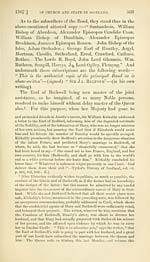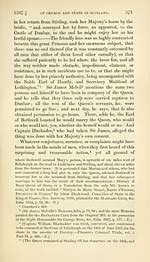Spottiswoode Society > History of the affairs of the Church and State of Scotland from the beginning of the reformation to the year 1568 > Volume 2
(594) Page 570
Download files
Complete book:
Individual page:
Thumbnail gallery: Grid view | List view

570 THE HISTORY OF THE AFFAIRS [1567-
Stirling two days after, viz. on the 21st, to visit the Prince
her son,i the Earl drew together a body of about 800
horsemen, under a pretence, some say, of marching into
Lidsdale to look after thieves and robbers, of which and
the other southern countries he was Lord Lieutenant for
the time ; but instead of going southward, as was given
out, he marched immediately to the west, and met the Queen
at Almond-Bridge^ on the 24th of the same month of April,
Thursday. I doubt not but you have heard how the Earl of Botliwell
has gathered many of his friends, and, as some say, to ride in Liddesdale,
but I believe it is not, for he is minded to meet the Queen this day called
Thursday, and to take her by the way and bring her to Dunbar. Judge
you if it be with her will nor no ; but you will hear more at length on
Friday or Saturday, if you will find it good that I continue in writing as
occasion serves. — At miduight."- MS. Letter, State-Paper Office. Mr
Tytler observes — " This letter, though undated, contains internal proof
that it was written on Tliursday, tlie 24th April, the day Bothwell carried
off the Queen to Dunbar." — Tytler's History of Scotland, vol. vii. p. 107,
108.— E.]
^ [Our Historian was apparently not aware of an interesting particular
connected with Queen INIary's visit to Stirling on this occasion. When
she arrived, the Earl of Mar, Governor of the Castle, who was responsible
for the safety of the infant Prince, and who was well informed of all the
rumours concerning Bothwell, refused to admit the Queen into the royal
apartments v>'ith more than two of her ladies. — MS. Letter, State-Paper
Office, Drury to Cecil, 27th April 1567, cited in Tytler's History of Scot-
land, vol. vii. p. 108.— E.]
^ It stands over Avon- water, a short mile to the west of the town of
Linlithgow, and is now commonly called Linlithgow-bridge. — [Our
Historian is most inaccurate in making Almond Bridge, where Bothwell
seized Queen Mary, to "stand over Avon Water" as there happens to
intervene a distance of probably fifteen, miles — the entire length of the
county of Linlithgow from east to west, and the locality which our Histo-
rian most erroneously assigns is the road-side hamlet of Linlithgow-
Bridge, upwards of a mile west of the burgh of Linlithgow, on the road to
Falkirk and Stirling. At that hamlet the Avon, not the Almond, is
crossed by a bridge. The seizure of Mary occurred near the bridge over
the river Almond. The river Almond, which enters the Frith of Forth
at the village of Cramond, partly divides the counties of Edinburgh and
Linlithgow, or Mid and West Lothian on the east ; and the Avon, which
falls into the Frith of Forth between Borrowstownness and Grangemouth,
is the boundary between the counties of Linlithgow and Stirling on the
west. Chalmers (Life of Mary Queen of Scots, vol. i. p. 216) merely states
that Bothwell at the head of 800 men seized the Queen at the Foulbrigfjs,
and in another place (vol. ii. p. 233), he assigns the locality as " near Edin-
burffh." This indefinite assertion seems to have misled Dr Luigard, who,
in his " History of England" (4to. edit. London, 1823, vol. v. p. 249),
shews his ignorance of the place, by mentioning the said " Foulbriggs"
as only "/(«// a mile from the Castle of Edinburgh:' (/ ) Almond Bridge^
Stirling two days after, viz. on the 21st, to visit the Prince
her son,i the Earl drew together a body of about 800
horsemen, under a pretence, some say, of marching into
Lidsdale to look after thieves and robbers, of which and
the other southern countries he was Lord Lieutenant for
the time ; but instead of going southward, as was given
out, he marched immediately to the west, and met the Queen
at Almond-Bridge^ on the 24th of the same month of April,
Thursday. I doubt not but you have heard how the Earl of Botliwell
has gathered many of his friends, and, as some say, to ride in Liddesdale,
but I believe it is not, for he is minded to meet the Queen this day called
Thursday, and to take her by the way and bring her to Dunbar. Judge
you if it be with her will nor no ; but you will hear more at length on
Friday or Saturday, if you will find it good that I continue in writing as
occasion serves. — At miduight."- MS. Letter, State-Paper Office. Mr
Tytler observes — " This letter, though undated, contains internal proof
that it was written on Tliursday, tlie 24th April, the day Bothwell carried
off the Queen to Dunbar." — Tytler's History of Scotland, vol. vii. p. 107,
108.— E.]
^ [Our Historian was apparently not aware of an interesting particular
connected with Queen INIary's visit to Stirling on this occasion. When
she arrived, the Earl of Mar, Governor of the Castle, who was responsible
for the safety of the infant Prince, and who was well informed of all the
rumours concerning Bothwell, refused to admit the Queen into the royal
apartments v>'ith more than two of her ladies. — MS. Letter, State-Paper
Office, Drury to Cecil, 27th April 1567, cited in Tytler's History of Scot-
land, vol. vii. p. 108.— E.]
^ It stands over Avon- water, a short mile to the west of the town of
Linlithgow, and is now commonly called Linlithgow-bridge. — [Our
Historian is most inaccurate in making Almond Bridge, where Bothwell
seized Queen Mary, to "stand over Avon Water" as there happens to
intervene a distance of probably fifteen, miles — the entire length of the
county of Linlithgow from east to west, and the locality which our Histo-
rian most erroneously assigns is the road-side hamlet of Linlithgow-
Bridge, upwards of a mile west of the burgh of Linlithgow, on the road to
Falkirk and Stirling. At that hamlet the Avon, not the Almond, is
crossed by a bridge. The seizure of Mary occurred near the bridge over
the river Almond. The river Almond, which enters the Frith of Forth
at the village of Cramond, partly divides the counties of Edinburgh and
Linlithgow, or Mid and West Lothian on the east ; and the Avon, which
falls into the Frith of Forth between Borrowstownness and Grangemouth,
is the boundary between the counties of Linlithgow and Stirling on the
west. Chalmers (Life of Mary Queen of Scots, vol. i. p. 216) merely states
that Bothwell at the head of 800 men seized the Queen at the Foulbrigfjs,
and in another place (vol. ii. p. 233), he assigns the locality as " near Edin-
burffh." This indefinite assertion seems to have misled Dr Luigard, who,
in his " History of England" (4to. edit. London, 1823, vol. v. p. 249),
shews his ignorance of the place, by mentioning the said " Foulbriggs"
as only "/(«// a mile from the Castle of Edinburgh:' (/ ) Almond Bridge^
Set display mode to: Large image | Transcription
Images and transcriptions on this page, including medium image downloads, may be used under the Creative Commons Attribution 4.0 International Licence unless otherwise stated. ![]()
| Permanent URL | https://digital.nls.uk/79611577 |
|---|
| Description | Volume II. |
|---|---|
| Attribution and copyright: |
|

